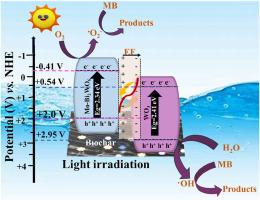Novel S-scheme derived Mo–Bi2WO6/WO3/Biochar composite for photocatalytic removal of Methylene Blue dye
IF 4.3
3区 材料科学
Q2 CHEMISTRY, MULTIDISCIPLINARY
引用次数: 0
Abstract
Presently, the distinct charge transport and interface interaction of the S-scheme heterojunction has garnered significant interest. Herein, a S-scheme-based charge transportation Mo-doped Bi2WO6/WO3/Biochar heterojunction was synthesized in situ using a coprecipitation technique to improve methylene blue adsorption and photocatalytic reactive oxygen species production. The doped Mo altered the band gap of Bi2WO6 to increase light absorption, which can facilitate electron-hole separation and transfer. Likewise, the S-scheme band structure improved sunlight utilization, enhanced the reduction and oxidation power of photogenerated electrons, and boosted charge carrier separation and transfer. Thus, due to the synergetic impact of doping and the S scheme band structure, the photocatalysts efficiently eliminated Methylene blue up to 87.5 % in 30 min of photoirradiation. Fabricated heterojunction Mo–Bi2WO6/WO3/Biochar photocatalyst have highest Kapp values 0.02816 min−1 while Mo–Bi2WO6/WO3, Mo–Bi2WO6, Bi2WO6, and WO3 photocatalysts have 0.02816, 0.02273, 0.01527, 0.00643, and 0.00735 min−1, respectively which was 4.38 times greater than pristine Bi2WO6. The study offers a novel perspective for the in-situ production of S-scheme heterojunction with doping to remove different types of contaminants.

用于光催化去除亚甲基蓝染料的新型 S 型衍生 Mo-Bi2WO6/WO3/Biochar 复合材料
目前,S 型异质结独特的电荷传输和界面相互作用引起了人们的极大兴趣。本文利用共沉淀技术原位合成了一种基于 S 型电荷传输的掺杂 Mo 的 Bi2WO6/WO3/Biochar 异质结,以改善亚甲基蓝的吸附和光催化活性氧的产生。掺杂的 Mo 改变了 Bi2WO6 的带隙,增加了光吸收,从而促进了电子-空穴的分离和转移。同样,S 型带结构提高了对阳光的利用率,增强了光生电子的还原和氧化能力,促进了电荷载流子的分离和转移。因此,在掺杂和 S 型能带结构的协同作用下,光催化剂在 30 分钟的光照时间内有效消除了高达 87.5% 的亚甲基蓝。制备的异质结 Mo-Bi2WO6/WO3/Biochar 光催化剂的最高 Kapp 值为 0.02816 min-1,而 Mo-Bi2WO6/WO3、Mo-Bi2WO6、Bi2WO6 和 WO3 光催化剂的 Kapp 值分别为 0.02816、0.02273、0.01527、0.00643 和 0.00735 min-1,是原始 Bi2WO6 的 4.38 倍。该研究为原位制备掺杂去除不同类型污染物的 S 型异质结提供了一个新的视角。
本文章由计算机程序翻译,如有差异,请以英文原文为准。
求助全文
约1分钟内获得全文
求助全文
来源期刊
CiteScore
7.80
自引率
2.50%
发文量
605
审稿时长
40 days
期刊介绍:
The Journal of Physics and Chemistry of Solids is a well-established international medium for publication of archival research in condensed matter and materials sciences. Areas of interest broadly include experimental and theoretical research on electronic, magnetic, spectroscopic and structural properties as well as the statistical mechanics and thermodynamics of materials. The focus is on gaining physical and chemical insight into the properties and potential applications of condensed matter systems.
Within the broad scope of the journal, beyond regular contributions, the editors have identified submissions in the following areas of physics and chemistry of solids to be of special current interest to the journal:
Low-dimensional systems
Exotic states of quantum electron matter including topological phases
Energy conversion and storage
Interfaces, nanoparticles and catalysts.

 求助内容:
求助内容: 应助结果提醒方式:
应助结果提醒方式:


